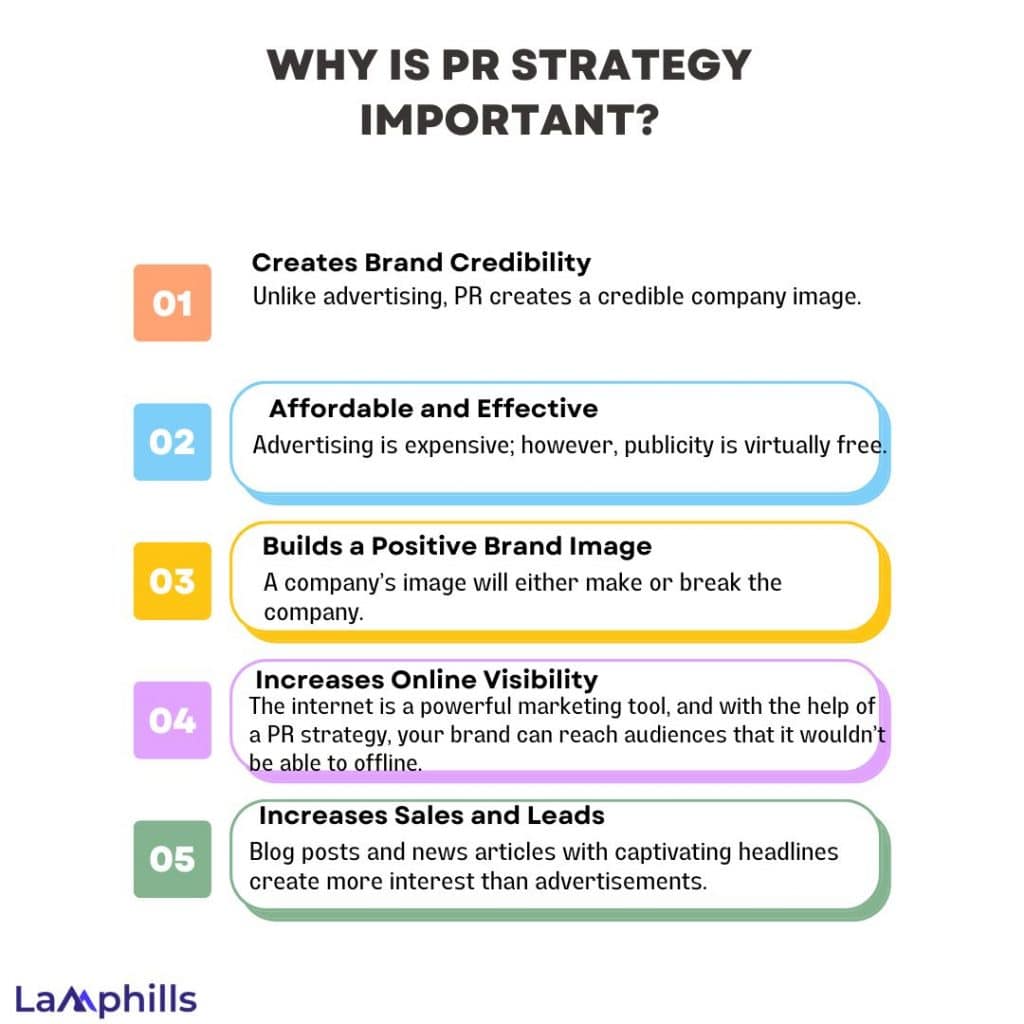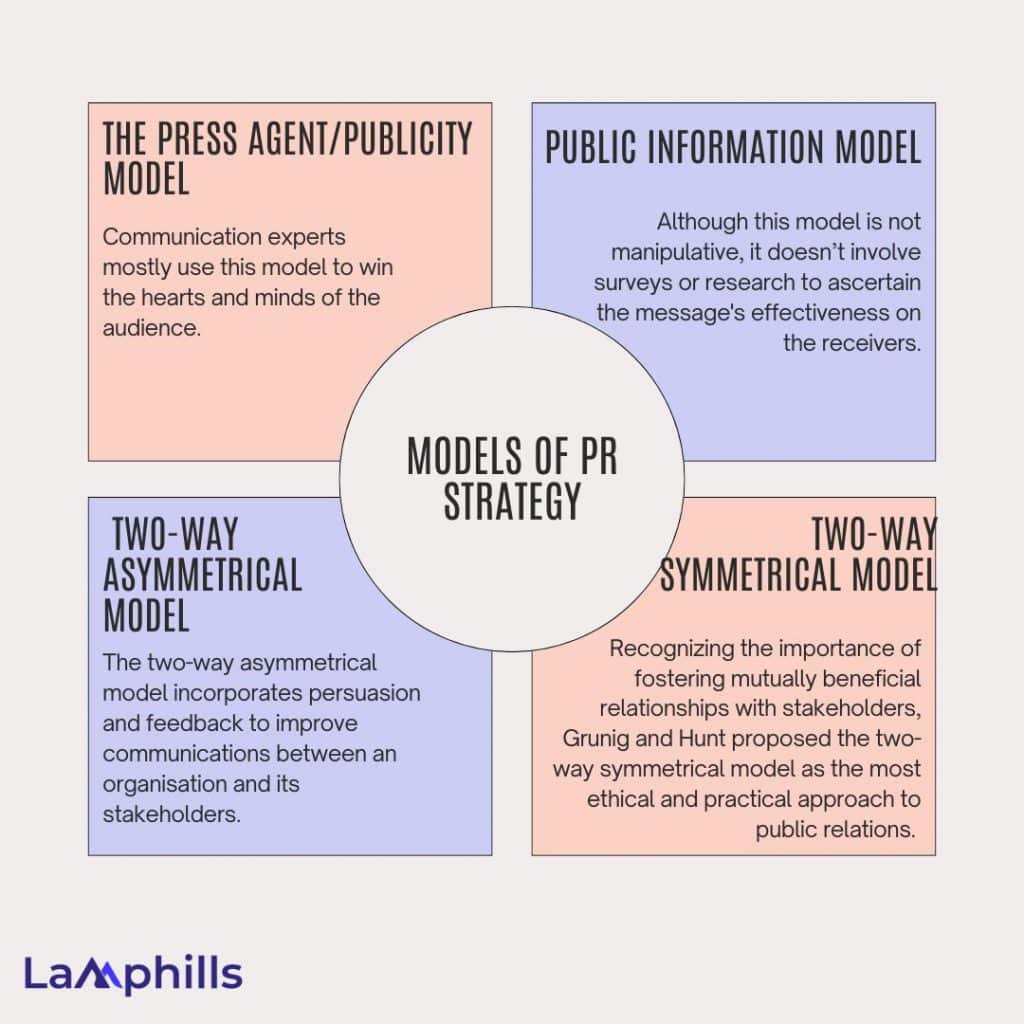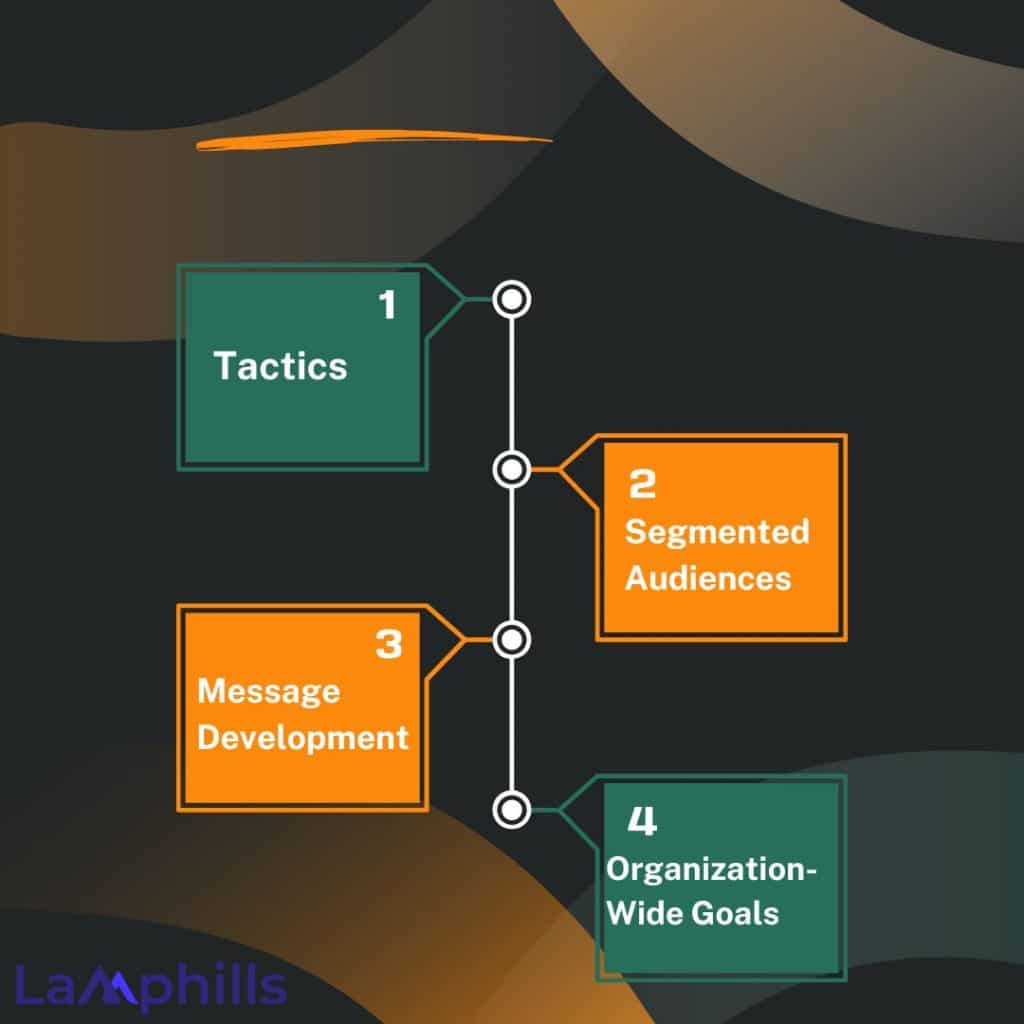An effective PR strategy is crucial in getting your brand in front of the people who want to see and engage with it. Rather than publishing content and crossing your fingers, you should have an action plan to help you reach specific goals. With good PR, you can influence buying behaviors and customer sentiment, cut through the noise, and position your brand in the right light.
Hence, if you plan your public relations strategy with a professional PR firm like Lamphills, you can increase the chances of acquiring relevant and high-authority media mentions to establish your brand as a leader in your niche. In this article, I will explain more about the importance of an effective PR strategy, how to create one, and the difference between marketing strategies. Read on!
Key Points
- A PR (Public Relations) strategy is a comprehensive plan designed to manage, shape, and maintain the public perception and image of an individual, organization, or brand.
- The importance of having a good and effective PR strategy includes creating brand credibility, being affordable and effective, building a positive brand image, increasing online visibility, and increasing sales and leads.
- The PR strategy models include the press agentry/public, public information, and two-way asymmetric and symmetric models.
- The main difference between marketing and PR is that marketing focuses on selling products, while PR focuses on maintaining the company’s positive reputation.
- Press releases, public events, crisis mitigation, social media, and strategic partnerships are examples of PR strategy.
What is PR Strategy?
A PR (Public Relations) strategy is a comprehensive plan designed to manage, shape, and maintain the public perception and image of an individual, organization, or brand. These methods help a company organize its public relations efforts to attract its target audience and identify ways to reach its goals during the planning stage. They’re similar to marketing strategies because the primary goal is to spread brand awareness.
See also: PESO MODEL: Maximizing Your PR Strategy & Effectively Implementing The PESO Model
Public relations strategies can also be helpful in crisis management because they allow organizations to respond to a negative situation and try to develop a possible outcome. A good plan can help companies increase their reputation if they overcome a negative situation. Businesses often rely on outlets, such as media sources, blogs, social media, or podcasts, to help them deliver messages for these strategies to a broader audience. PR professionals group these into three categories, which are:
#1. Owned Media
Owned media is any content that your business controls. It’s often the go-to strategy for businesses looking to build a PR campaign.

Rightly so, as it’s arguably the most important type of PR-related media that you should focus on. Unlike the other two media tactics, you have total control over it.
Owned media includes:
- Social media posts
- Blog content
- Website copy
- Email newsletters
Owned media acts as a “home base” for your PR activity. When people write about your brand or products, they’ll likely reference (i.e., link to) your owned media in their coverage.
#2. Paid Media
It’s not uncommon to pay to promote your content in the marketing world, and it’s no different when it comes to PR.

Paid media refers to spending to make your content visible. It’s standard practice to promote owned media.
Paid media includes:
- Social media advertising
- Influencer marketing
- Pay-per-click (PPC)
Putting some funds toward boosting PR content is becoming increasingly popular. Since most social platforms are reducing organic reach for business accounts, paid media is a fantastic way to ensure your content gets in front of the people you want to see.
#3. Earned Media
Earned media boosts conversation around your brand. It’s essentially word-of-mouth and is arguably the best PR tactic for building your reputation.
Earned media is the hardest type of PR media to obtain. Establishing it requires effort, consistency, and hard work, so it’s “earned.”
Earned media includes:
- Mentions in industry news and reviews
- Praise from customers on social media
- High rankings on search engines
These media avenues provide ways to use PR to build brand awareness, generate leads, and convert those leads into paying customers — similar to your marketing. Now, let’s discuss the difference.
Read more: EARNED MEDIA: Definition, Examples, and Best Practices
Why Is PR Strategy Important?

When our startup launched some years back, we had a fantastic product but needed more visibility. Our competitors, with a mediocre offering, were everywhere—thanks to their robust PR strategy. Desperate, we hired a seasoned PR professional who crafted compelling narratives and secured features in top industry publications.
Within months, our brand recognition soared. Investors started calling, and our sales tripled. The turning point was a glowing article in a leading business magazine that positioned us as industry innovators. Thinking through these experiences taught me the critical role of PR in building a brand and shaping its future success. Below are the importance of having a good and effective PR strategy.
#1. Creates Brand Credibility
Unlike advertising, PR creates a credible company image. How often have you scrolled through a website, and underneath an article or headline, you see the words “sponsored content” or “promoted by…”? Suddenly, the value and trustworthiness of the information you’re reading dwindles. This is an excellent example of how organic news coverage is more credible than a paid advertisement.
Moreover, with exposure to approximately 4,000 to 10,000 ads daily, most of us tend to become desensitized and more likely to ignore them. The benefit of PR is the information about the goods or services does not identify a sponsor. It comes from an independent source, making it more trustworthy.
#2. Affordable and Effective
Advertising is expensive; however, publicity is virtually free. Advertising requires you to purchase space in a publication, but with publicity, being featured in the magazine is free. Publicity is proof that there is power in numbers. For instance, PR generates much readership and viewership by publishing content in newspapers, magazines, news channels, websites, blogs, and television programs. Being published in print media such as newspapers and magazines is a great promotional tool because it is organic.
Publicity allows for more information to be disseminated than advertising. Because of limited sponsored content space, many essential details must be cut out. However, a perk of publicity is its long-form nature. For example, press releases, newspaper articles, and blog posts are abundant in information.
#3. Builds a Positive Brand Image
A company’s image will either make or break the company. 90% of potential customers use reviews and online mentions to determine whether or not to purchase products or services, which is why a positive brand image is crucial. Customers are more likely to support a brand with a positive image because it is seen as being more credible.
A positive image creates interest in your business; reputation management is critical to maintaining it. Reputation management repairs damage such as negative reviews, advertising gone wrong, and overall backlash that a brand could face. This is why PR strategy is vital for branding.
#4. Increases Online Visibility
The internet is a powerful marketing tool, and with the help of a PR strategy, your brand can reach audiences that it wouldn’t be able to offline. For example, social media, blogs, and press releases can boost search engine optimization (SEO) and increase website traffic. PR increases overall brand visibility, which is good because consumers are more likely to buy your goods or services when a brand is familiar. A solid online presence creates several opportunities to increase sales and ultimately expand the company.
#5. Increases Sales and Leads
Blog posts and news articles with captivating headlines create more interest than advertisements. Why? Because they focus on a story as opposed to the product. Due to the long-form nature of PR, testimonials and case studies are a great way to spark a consumer’s curiosity. Positive reviews and word-of-mouth referrals increase sales and leads.
Moreover, it can lead to a snowball effect, in which good press leads to even more good press. Another great strategy is creating a press or media section on your website. This will establish credibility and increase sales.
An effective PR strategy is a crucial component of a successful business. At virtually no cost, publicity offers extensive benefits, including credibility, effectiveness, a positive brand image, and a robust online and community presence. Most importantly, it leads to growth opportunities and increased business profits.
Models of PR Strategy

The public relations strategy models, which elaborate on different managerial and organizational practices, were developed by Grunig Hunt in 1984. These models help organizations develop guidelines, plans, and programs to stay ahead of the competition.
The models include the press agentry/public model, public information, two-way asymmetric, and two-way symmetric models. Each is explained below.
#1. The Press Agent/Publicity Model
Communication experts mostly use this model to win the hearts and minds of the audience. It is based on propaganda and doesn’t involve any surveys or research. The main target of this model is to manipulate how the audience reacts to specific information.
The publicity model is a one-way communication model, as the recipients of this communication are not given a chance to respond. Instead, it’s centered on creating a positive company image in prospects’ minds.
#2. Public Information Model
Although this model is not manipulative, it doesn’t involve surveys or research to ascertain the message’s effectiveness on the receivers. It is also a one-way communication model, though it tends to relay accurate information about a company.
The public information model focuses on educating the public about a company or organization. Some formats used to relay this information include brochures, magazines, press releases, and newsletters.
Most of the time, public relations experts regularly send this information to various prospects to raise brand awareness.
#3. Two-Way Asymmetrical Model
The two-way asymmetrical model incorporates persuasion and feedback to improve communications between an organization and its stakeholders. This approach, which gained prominence in the mid-20th century, relies on research and understanding of the target audience to craft tailored messages that resonate with their values and preferences.
The primary goal of the two-way asymmetrical model is to influence public opinion while simultaneously taking audience feedback into account.
Although this model significantly improves on its predecessors in terms of audience engagement, it still prioritizes the organization’s objectives over the needs and concerns of its stakeholders.
#4. Two-Way Symmetrical Model
Recognizing the importance of fostering mutually beneficial relationships with stakeholders, Grunig and Hunt proposed the two-way symmetrical model as the most ethical and practical approach to public relations. This model emphasizes open, transparent communication, wherein the organization and its stakeholders engage in a dialogue to better understand each other’s perspectives, values, and concerns.
The two-way asymmetrical model promotes collaboration, trust, and long-term relationship building by seeking a balance between the interests of both parties.
This approach is increasingly recognized as the gold standard for public relations practice in today’s interconnected and globalized world.
Examples of a PR Strategy
To further clarify and support your understanding of public relations, here are some examples of PR strategies you might use:
#1. Press Releases

Written press releases are a classic PR strategy. They are prepared by an organization’s public relations team and sent to news media for potential coverage in print, television, and online stories. Companies might issue a press release when they host a function, like a fundraiser.
They might also do so when they reach a significant milestone, such as several years in business or a particular number of operating locations. Organizations also sometimes issue press releases in response to news events that affect them. This can support open communication and leverage media to the organization’s advantage.
#2. Public Events

Organizations sometimes host public events to bolster their public relations efforts. For example, a company might hold a celebratory luncheon with free refreshments and product samples to recognize their anniversary after several years in business. These functions can help increase a company’s visibility and support public goodwill toward its organizational ethos.
#3. Crisis Mitigation

Responding to crises can be another useful PR strategy. This is true if the crisis directly impacts the organization or brand because the PR response can demonstrate the company’s values and mission to the public with a sense of urgency. It can also be valuable when a crisis affects the company tangentially or secondarily, depending on the context, because some customer demographics are interested in companies’ positions on public issues and current events. Careful research and analysis can support this strategy’s success.
#4. Social Media

Social media can be both an earned and paid PR tactic.
It can be a helpful PR (and marketing) tool for most companies—it’s an effective way to amass followers, convert customers, share content, and resolve crises.
Whether you share a post with your audience or interact with a single customer, your social media activity is open to the public. That’s why having a social media strategy that keeps your communications consistent, positive, and accurate is critical.
#5. Strategic Partnerships

Strategic partnerships result when two or more organizations work together to accomplish a common communication goal. This might occur when their services are complementary without directly competing, such as two types of food products that go well together.
Companies might also partner to promote products and services that complement one another or support a common mission—for example, a clothing company partnering with a popular nonprofit to produce branded merchandise that spreads awareness of both organizations. This can be especially useful when the public trusts one or more partnered brands.
Now, let’s talk about how to create a PR strategy. You can use the template I provided below to create a comprehensive PR strategy
PR Strategy Template
Lamphills PR Strategy Template
Most Effective PR Strategies for 2024
A well-crafted PR management strategy shapes your brand’s narrative, fosters meaningful media connections, and contributes to your overall business objectives. Here are the best public relations strategies for 2024 and ahead:
#1. Develop a Clear Communication Strategy
A communication strategy is the guiding compass that directs your PR strategy toward achieving impactful and meaningful outcomes.
Start by defining your goals—enhancing business awareness, launching a new product, or addressing a specific issue.
Next, identify your target customers and understand their demographics, preferences, and pain points. This knowledge will help you tailor your messages to resonate with them effectively.
Below is a sample communication objectives worksheet I provided for each audience segment, including their primary limitations and the intended change outcomes.
| Objective Component | Explanation | Example |
| Audience Segment | Who needs to make the change? | Married women, currently not using FP, have one child and desire to have more children later. |
| Key Constraint | Married women, currently not using FP, have one child, and desire to have more children later. | These women believe nobody else uses FP and worry about what the community would think if they used FP. |
| Desired Change | What does the audience need to change or do? | Believe that others in the community use and approve of FP. |
#2. Create Quality Press Materials
High-quality press materials are a PR strategy essential for grabbing media attention.
Your press releases should be well-structured and concise and include all relevant information to help you acquire media mentions.
Additionally, create informative articles and content that provide value to your target consumers. This can position your company as a reliable source of industry insights and establish your authority in your field.
#3. Build Relationships with Journalists
Developing relationships with media journalists is crucial for securing media coverage. Begin by researching media journalists who cover topics related to your industry. You can use platforms like HARO to connect with journalists.
Familiarize yourself with their work and preferences to tailor your pitches effectively. When contacting media professionals, provide valuable information or exclusive insights that align with their interests.
Building a reputation as a helpful and reliable source can lead to ongoing media coverage and partnerships.
#4. Establish an Online Presence
Maintaining a strong online presence is important for successful public relations strategies.
Around 89% of businesses agree that firms that don’t invest in social media promotion are left behind. Therefore, creating social media profiles on top social channels like Facebook, Instagram, Twitter, LinkedIn, Pinterest, and other platforms is crucial.
Ensure you maintain an active social media presence by significantly amplifying your company’s visibility.
Regular posts and interactions keep your business at the forefront of users’ feeds, enhancing brand recognition and recall.
#5. Organize Press Conferences and Events
Press conferences and events provide platforms to share significant announcements and engage with the media. These events capture media attention and allow you to convey your messages directly, thereby expanding the reach of your public relations campaigns.
Ensure that your events are well-organized and informative. Offer opportunities for media representatives to interact with your business and gather valuable content for their stories.
#6. Use Local Media
Most companies know which major and national media outlets can help them get the most exposure, so it can be more difficult to get an edge through that. However, supplementing your media involvement to include regional or local sources your target audience follows and trusts can help you earn their trust and reach new market segments. If your message is compelling enough, national media might notice and spread it, too.
#7. Provide Research and Expert Opinions
Positioning your company as an authority in the field is an effective public relations strategy.
Publicize research results, media outlets, and professional viewpoints on subjects related to your area of expertise. To maintain consistency, set up a regular schedule for material publishing. Maintaining a regular schedule, whether weekly, bi-weekly, or monthly, keeps you at the forefront of your clients’ and colleagues’ minds.
Engage in active content sharing with members of your industry associations, internet communities, and professional network. Remember to participate in conversations and solicit comments to increase your audience and foster relationships.
#8. Create Reliable Video Content
Video material is interesting and gives you a visual platform to present your skills. 92% of marketers attest to video’s good return on investment.
Make movies containing product demos, industry expert interviews, and instructional material.
Ensure that all of your brand’s components—including logos—are incorporated into the videos for your PR campaigns. Remember to post your videos to your website, LinkedIn, Facebook, Instagram, YouTube, and other channels.
Read also: Video Storytelling: Its Benefits to Your Brand
Marketing and PR Strategy: Comparisons

You’ve heard it often: ” marketing ” is used interchangeably with “public relations.” But are they really the same thing?
While they may support one another and be used to drive a similar outcome, marketing and public relations are very different.
The differences lie in how marketing and public relations strategies contribute to an organization’s success through strategic tactics, segmented audiences, message development, and organization-wide goals.
#1. Tactics
The primary marketing strategy in the public sector is to use promotional material to target a specific audience. Marketing leverages promotional content on various channels, including email, social media, blogs, billboards, and television ads.
Public relations strategies in the public sector generally include a targeted media strategy, including sending press releases and pitches to media to garner coverage in publications. Stakeholder communication is valuable to any PR strategy and can be accomplished on various platforms, including social media.
While the platforms may overlap (sending an email to your audience with a recently published article, for example), the tactics vary because they are meant to connect with different audiences: marketing is geared towards citizen action, whereas public relations focuses more on stakeholders.
#2. Segmented Audiences
Marketing and public relations target different audiences. Marketing is typically used to reach an audience, hoping they will engage or participate. In the public sector, this would be your citizen-based audience—whether they are new to your organization or have been interested in your information for years, marketing can be used to engage and re-engage your audience to help impact your outcomes.
Public relations is primarily about reputation building, so targeted audiences include key stakeholders (legislators, event sponsors, employees, and community partners). A solid PR campaign includes at least some segmentation by the audience and uses paid or earned media to connect with them.
#3. Message Development
Marketing messaging is typically recognized as actionable material. Think about the last email you received from your favorite clothing brand—they probably used messages like “50% off sale” or “Hurry before they’re all gone!” In the public sector, we use a similar tone and Calls to Action (CTAs) to encourage our audience to click on a resource.
In Public relations, messaging is typically reinforced with a positive but factual tone. Articles, speakers, or bloggers tell a story, and public relations is used to develop that story and build a better reputation. Credible sources—local, statewide, national, or international outlets—can greatly impact the visibility of your message.
#4. Organization-Wide Goals
Ultimately, we use marketing and public relations strategies to accomplish different goals in the public sector.
Marketing targets current and potential members of your audience but seeks an outcome in return. In another way, marketing increases audience reach while promoting a particular measure. In the private sector, the goal is typically to boost sales. This could include volunteer recruiting, vaccination guide downloads, or license renewals in the public sector.
Public relations is focused on maintaining or enhancing an organization’s reputation. It uses external platforms to tell a story, establish credibility, or influence the public’s perspective. The goal is to garner earned media to increase your audience and stakeholders’ awareness of your program, service, or campaign and maintain a certain view or perspective.
Both marketing and public relations strategies play substantive roles in accomplishing public sector goals. While they can support one another in an integrated strategy, it’s important to understand the differences so you can track success.
Bottom Line
Hopefully, you’ve understood that having a comprehensive PR strategy is essential for any PR campaign. There are many details to pay attention to and practices to keep in mind. These include the importance of research, the different kinds of media, the importance of clearly defined goals, and measuring these to assess whether or not your tactics and strategy are working.
Either way, a good PR agency like Lamphills can manage everything necessary for the successful launch and execution of your campaign—from the generation of goals and objectives to the report on how the content and its publicity have impacted those aims.
Similar Articles
- HOW TO MEASURE BRAND AWARENESS: Tips To Improve Your Brand Strategy
- Top 12 Digital PR Agencies Worldwide + Free Strategies
- PR for B2B Companies: Tailoring Your Approach to Reach Decision-Makers
- How to Pull off a PR Stunt in 2024 With Examples






